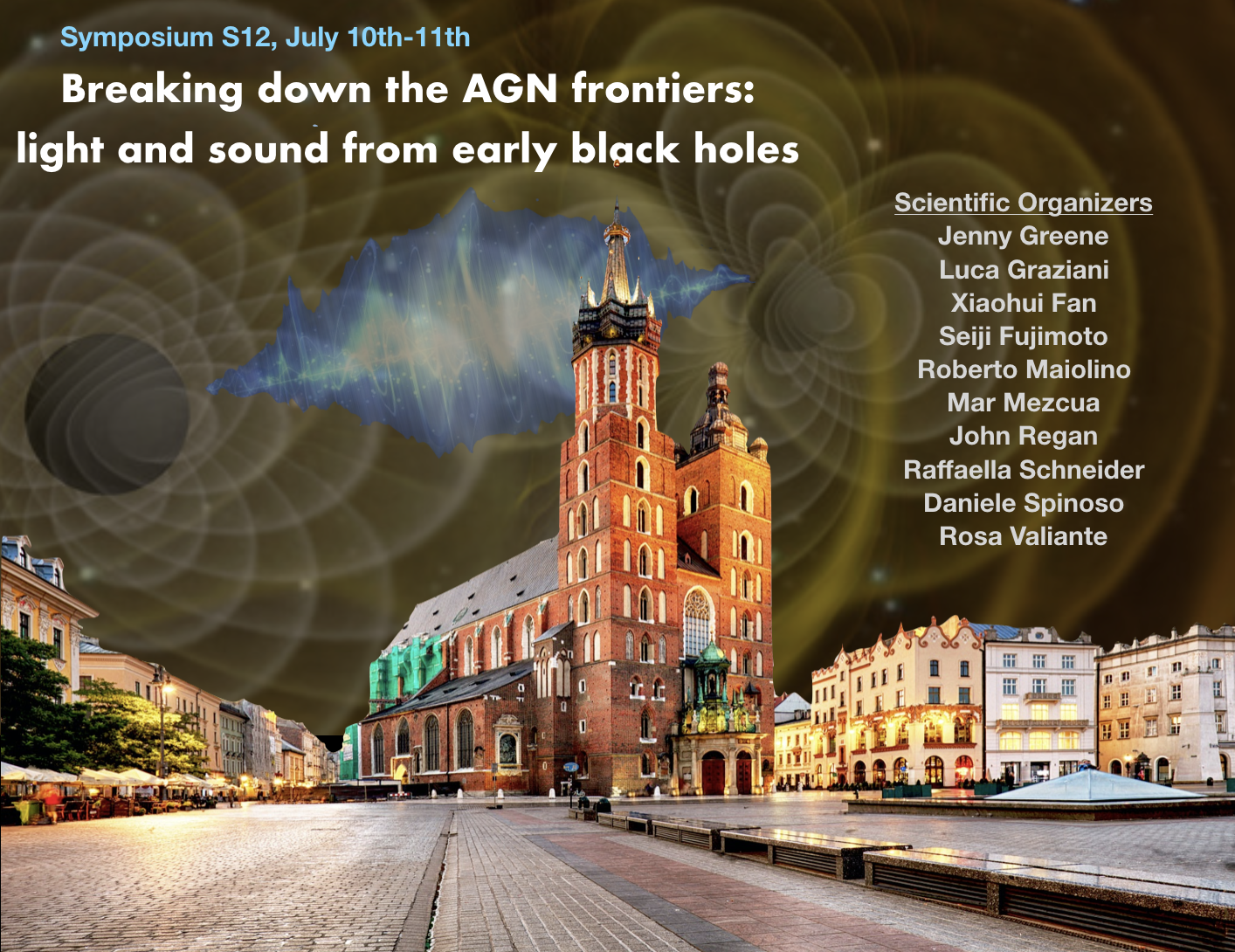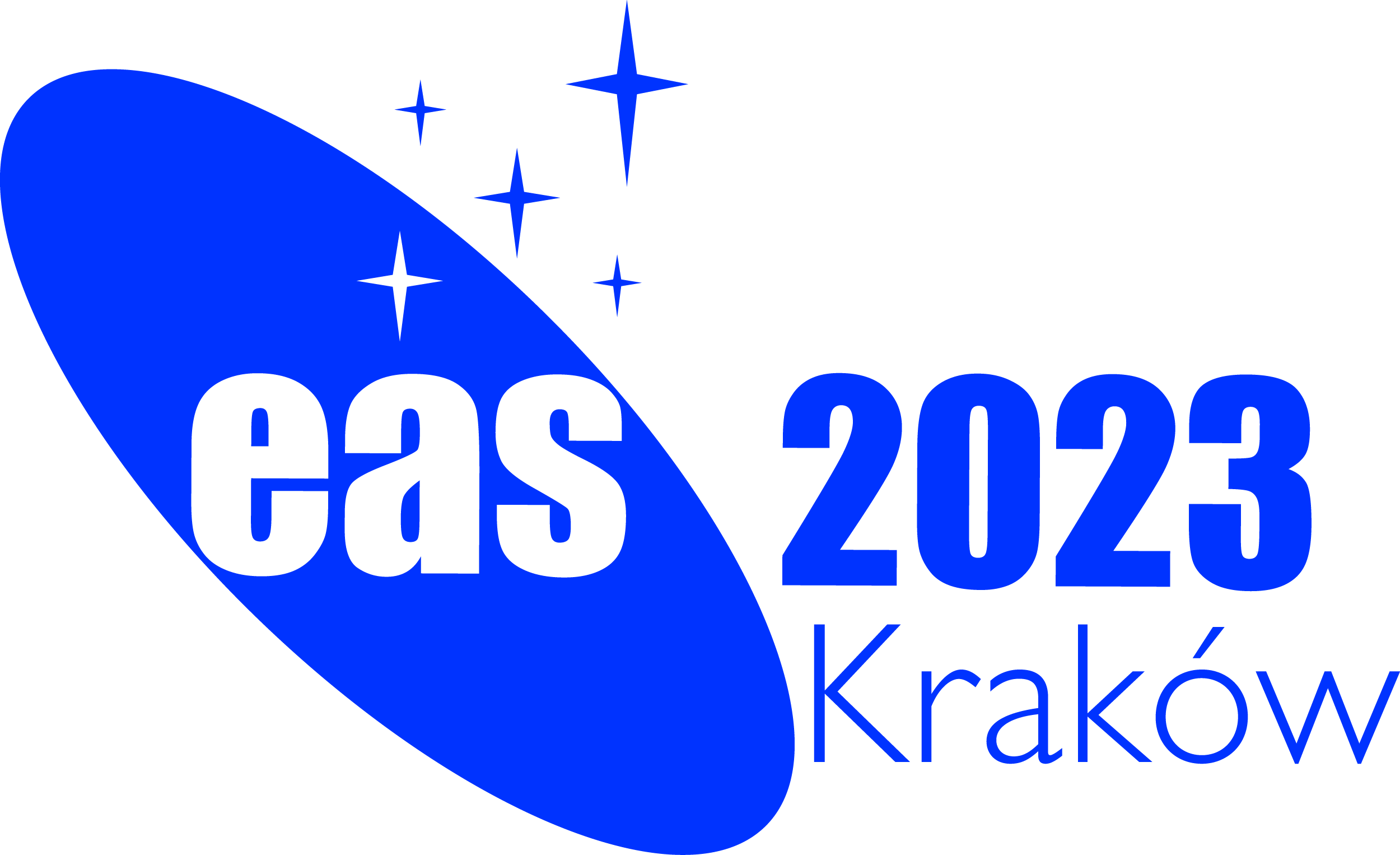Symposium S12
10-11 July 2023
Breaking down the AGN frontiers: light and sound from early black holes

Aims and scope
To date we have discovered more than 200 quasars at z>6 powered by accreting black holes with masses up to 109 - 1010 M⊙.
The physical mechanisms driving/regulating their formation and evolution are among the most debated issues in Astrophysics.
With the first load of data incoming from JWST (with most Cycle 1 programs likely executed) and in view of the future campaigns/missions like Athena, LISA, ET, it is urgent to set the stage for interpreting observational information, refine/develp models, tools as well as selection strategies.
In this Symposium we will discuss the most recent advances in theoretical and observational studies of supermassive black holes at the reionization epoch as well as the cosmic evolution of the seeds out of which they form.
In detail, we will review the state of the art of:
1. theoretical studies for the formation and growth of early black holes (from the seeds to the supermassive) including black hole dynamics, comparing the results of different approaches (e.g. analytical models and numerical/hydro simulations). We foresee to foster discussion on the relevant processes operating on different scales and in different physical regimes relevant to black holes.
2. observational campaigns devoted to study both high-z quasars and seed black hole relics in the local Universe with the aim of i) characterizing the population of (rare) titans at the reionization epoch and their less luminous counterparts (fainter AGN) and i) to build ?complete? mass/luminosity functions across cosmic epochs.
3. development of observational, multi-wavelength/messenger strategies to detect signatures of accreting and merging black holes.
The final goal of the meeting is to discuss ongoing and future projects, foster and consolidate collaborations within the scientific community.
Programme
Preliminary list of topics:
- The formation of BH seeds
- The early growth of the first SMBHs: the state of the art of theoretical/cosmological models
- Physical properties of the first QSOs (BHs, host galaxies and their environment)
- BH dynamics across time and space
- Observational signatures: light (EM diagnostics) and sound (GWs) from early BHs
- Constraints from lower-z/local relics - the search for intermediate mass black holes
Invited speakers
- Eduardo Banados (Max Planck Institut fur Astronomie, Heidelberg, Germany)
- Silvia Bonoli (Donostia International Physics Center, Donostia-San Sebastián, Spain)
- Elisa Bortolas (Dipartimento di Fisica G. Occhialini Universitŕ; degli Studi di Milano Bicocca, Italy)
- Alessandra De Rosa (IAPS/INAF - National Institute for Astrophysics)
- Katja Fahrion (European Space Agency in Noordwijk, the Netherlands)
- Melanie Habouzit (Max-Planck-Institut für Astronomie, Heidelberg, Germany)
- Zoltan Haiman (Columbia University, New York, USA)
- Kohei Inayoshi (Kavli Institute for Astronomy and Astrophysics, Peking University)
- Alberto Mangiagli (Université Paris Cité, CNRS, France)
- Amy Reines (Montana State University, USA)
- Hyewon Suh (Gemini Observatory / NSF's NOIRLab)
- Feige Wang (Steward Observatory, University of Arizona, USA)
Scientific organisers
Jenny Greene (Department of Astrophysical Sciences, Princeton University, Princeton, USA)
Luca Graziani (University of Rome, la Sapienza, Italy)
Xiaohui Fan ((Steward Observatory, University of Arizona, USA)
Seiji Fujimoto ((University of Texas, Austin, USA)
Roberto Maiolino ((Kavli Institute for Cosmology, University of Cambridge, UK)
Mar Mezcua (Institute of Space Sciences, Barcelona, Spain)
John Regan (Maynooth University, Ireland)
Raffaella Schneider (University of Rome, la Sapienza, Italy)
Daniele Spinoso (Tsinghua Beijing, China)
Rosa Valiante (INAF-Astronomical Observatory of Rome, Italy)
Contact
SOC co-chairs:
S12 official email address: eas2023symposium12 @ gmail.com
Mar Mezcua marmezcua.astro @ gmail.com
Daniele Spinoso dspinoso @ outlook.it
Rosa Valiante rosa.valiante @ inaf.it
Updated on Wed Apr 12 10:52:09 CEST 2023
|

 A power cut will shut down all EAS services on Tuesday, 10 January 2017 starting at 7:30 CET.
A power cut will shut down all EAS services on Tuesday, 10 January 2017 starting at 7:30 CET.


